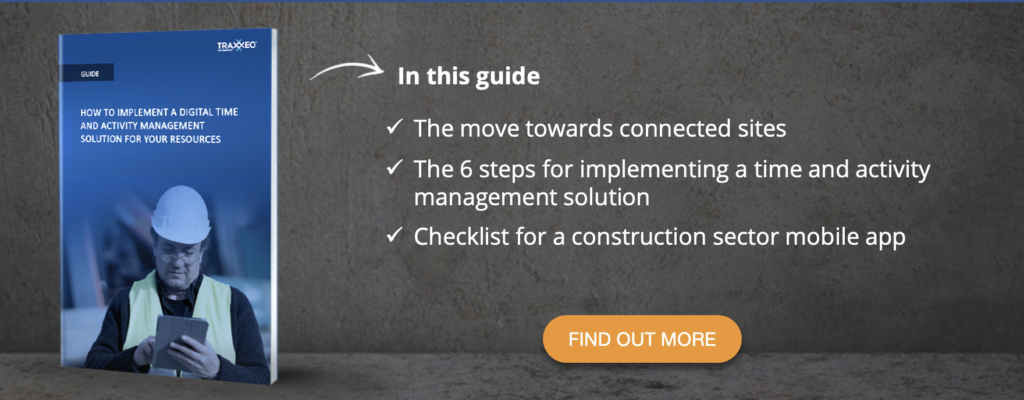
SAP, Sage, Oracle, Cegid… to ensure efficient management of business activities, it is vital to choose the right ERP software.
Once the choice has been made, there is still the issue of knowing how to deploy it effectively on sites. To do this, there are now dedicated mobile applications available.
Find out what you can use to get the most out of an effective ERP that is perfectly deployed for your mobile workforce, and what benefits you can gain from it.

What is an ERP?
First of all, what exactly is an ERP? ERP is the abbreviation for ‘Enterprise Resource Planning’. The French translation ‘Progiciel de Gestion Intégré’ (integrated management software), or PGI, is also used.
ERP is a tool for managing a company’s activities. It enables the management of the company’s various operational processes to be centralised around a unique database.
The ERP is comprised of different modules, each dedicated to a specific activity (finance management, stock management, sales management, human resource management, etc.).
By integrating several management functions within one software package, ERP is like the ‘backbone’ of the company.
Which ERP to choose?
The first step to obtaining optimal results is to choose the best ERP for the company. There is now a wide range of ERP solutions on the market: SAP, Sage, Oracle, Cegid… How do you choose the best ERP for your company’s needs?
Identify your needs
To determine which management software will best meet your expectations, identify the main functionalities you need and which ones are secondary: management of stock, accounting, payroll, etc.
… and the profile of your company
In addition to the industry sector, you need to take into account the size of your company. Some management software solutions are better suited to microbusinesses or SMEs, whereas others are designed for managing the business activities of larger groups.
The final choice: needs vs budget
Finally, between an ERP that is generalist or specialised, paid or free, SaaS or open source… the choice will depend as much on your needsas yourbudget. Unsurprisingly, the free or least costly solutions will have more limited functionalities.
Construction industry: how to optimize the use of your ERP
Choosing the best ERP is one thing. Being able to deploy it effectively is another. Let’s find out about the specific difficulties of deploying an ERP for a mobile workforce in the construction industry, and how to overcome them.
Data, the fuel of your ERP
Although the ERP is the ‘backbone’ of your company, it can’t function alone. As effective as it may be, all software has to be powered by raw material: data.
Data is the ‘fuel’ of your ERP. Without it, even the best software is useless. To function optimally, the ERP requires a high-quality fuel: data that is rich, reliable and up to date.
The difficulties of data collection in the construction industry
In the construction industry, field data is difficult to collect. However, the majority of employees work in the field.
To effectively capture the data (hours, activities, etc.) from this mobile workforce, there are now solutions available that are much more efficient than paper or Excel.
A mobile application integrated with your ERP: the solution?
The Digital Timesheets™ application is an activity collection tool designed for the construction industry. Data captured in the mobile application is immediately available in your ERP software.
Upstream, the essential information is integrated in the mobile application. Thus, the cost structure, or Work Breakdown Structure (WBS), is available directly in the application.
This cost structure includes all of the site codes and different phases, jobs and activities that make up each project.
The captured data is allocated directly to the correct site, phase, etc. and is transmitted both validated and error-free to your ERP.

What are the benefits of an optimized ERP?
Using an efficient ERP powered by reliable data offers numerous advantages.
Accurate monitoring of labour costs
Among them, the main one is without doubt accurate monitoring of labour costs.
Thanks to Digital Timesheets™, financial controllers have access to a real-time view of the hours worked. And this is for not only each project but also each phase, activity or specific job.
Being able to compare the worked hours to the budgeted hours at any time enables extremely reactive financial monitoring, in order to avoid any budget overrun.
An accurate view of the hours worked also provides reassurance that the invoiced hours for the work of interims and subcontractors correspond to the reality on the ground.
Optimal site management
If the company is a ship, your ERP is the steering tool. It ensures the course is maintained so your objectives are met day after day, year after year.
Reporting, or presenting data in the form of reports, is an essential tool for this. Key information can be presented in the form of dashboards in order to maintain an overview of all your indicators at one glance.
Powered by reliable data captured by the Digital Timesheets™ application, these reports enable you to immediately target the points to be improved. This could be: productivity of a given activity, accuracy of quotes, hours invoiced by interims, adherence to schedules, etc.
Considerable time savings
ERP is a management software designed to communicate with its environment. The principle of this software is to centralise the management of activities around a common database. Integration of the ERP with the Digital Timesheets™ field data collection solution does exactly this: data is only entered once, at source.
The ERP and the software solutions operating around it enable the automation of numerous processes, or a considerable reduction in their administrative burden.
In the field or in offices, activities are carefully monitored and managed, while the work time is devoted to activities with a higher added value.
Related benefits
In addition to the benefits of better performance resulting from the ERP, capturing time and activities with Digital Timesheets™ also generates significant benefits in terms of HR management, payroll management and even enrichment of the BIM model.
How to optimize the performance of your ERP from tomorrow
How do you deploy an activity collection tool for your workers? How do you ensure adoption of the tool? How long will it take to see a return on your investment?
Our experts will be pleased to respond to your questions and discuss your challenges in order to provide you with the most suitable solution.
Contact us now and let’s discuss it:
